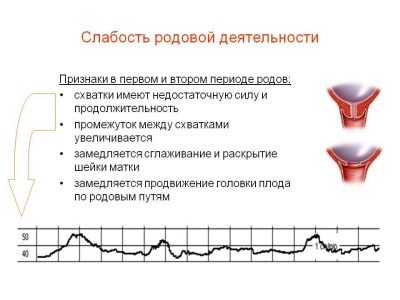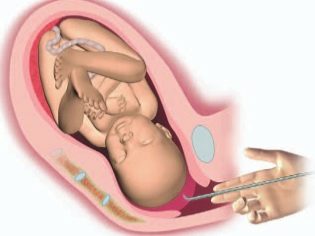Can the contractions stop?
It is believed that the process of contractions is irreversible. If they began in childbirth, then it is not possible to stop or weaken them.
If we talk about the impact from the outside, the contractions are really almost impossible to control. But for a variety of reasons, they can stop and weaken. In this article we will talk about why generic weakness develops and what to do if this happens.
The reasons
In normal childbirth contractions increase in time and duration, in strength and intensity. This is necessary to open the cervix so that the baby can leave the mother's womb. A situation in which contractions are not strong enough or were regular, and then ended, is considered a complication of the birth process. If contractions slowed down, they talk about primary generic weakness. If the attempts stopped, they talk about the secondary weakness of the tribal forces.
Termination of uterine contractions during labor is abnormal. And the reason for that is hypotonia of the smooth muscles of the uterus. Reduced uterine tone can result in:
- hypoplasia of the uterus;
- myoma;
- endometritis;
- uterine abnormalities - saddle or two-horned uterus;
- the failure of uterine tissue due to previous abortions or diagnostic curettage;
- scars on the cervix in nonpartum women due to erosion treatment;
- high levels of progesterone in the woman’s body, reduced levels of oxytocin;
- hypothyroidism, obesity;
- age of the woman in labor is up to 20 years or older than 36 years
- preeclampsia.
Most often, such a complication occurs in women who give birth to a first-born child; in the second or subsequent birth, the likelihood of developing weakness of labor forces is minimal, although it is not completely excluded.
According to statistics, up to 7% of all nulliparoids face weakening of contractions or attempts, among multiparous this happens in 1.5% of cases. Most often, contractions abruptly stop during preterm labor or during a post-term pregnancy. At risk of sudden weakness of labor forces - women carrying a large baby, several babies at the same time, since the walls of the uterus in this case are over-stretched.
The stopping of labor activity threatens both women with high water and those whose pelvic dimensions do not correspond to the size of the fetal head. Too early rupture of amniotic fluid is also a cause of the development of weak contractions. In addition, such factors as placenta previa, fetal hypoxia, and developmental defects of the baby may also be affected.
Quite often, doctors can not determine the reasons for the sudden stop of contractions or slowing them down. With good tests and perfect health, a woman’s labor can be slowed down for psychogenic reasons.
If the child is unwanted, if there is a strong fear of childbirth, if the woman was very nervous in the last days before childbirth, was in the epicenter of family conflicts, did not get enough sleep, was poorly nourished, the development of so-called idiopathic weakness of childbirth is possible.
Sometimes it is caused by too many anesthetic drugs, which the woman took on her own initiative, for fear of pain in contractions or entered into the hospital, but the latter is the least likely.
Effects
If you do nothing and adhere to waiting tactics, the likelihood of negative consequences will increase with each passing hour.
The baby may become infected, because the uterus is already partially ajar. A long anhydrous period is dangerous hypoxia, the death of a child. If the weakness occurred in the second half of the birth, then heavy bleeding may begin in the mother, asphyxiation and injury in the baby are not excluded.
What to do?
The woman herself just needs to monitor the duration and frequency of contractions in order to notice the lag in time. In case of pathological weak contractions, the intervals of rest between uterine spasms are approximately 2 times more than the norm, and the contraction lags behind the norms in duration.
All the rest must be decided by doctors. First of all, they need to understand how far the disclosure of the cervix lags behind the norm during primary contractions. Then it will be decided on further action. So, sometimes it is enough to insert a catheter into the woman's bladder or to puncture the membranes during polyhydramnios, and the birth activity resumes and then proceeds normally.
If a woman is very tired, she is exhausted, and the baby has no signs of trouble, hypoxia, then the woman can introduce sleeping pills so that she can sleep a little, after which labor activity can resume independently.
If these measures do not help, a woman can be stimulated to give birth, for which oxytocin is administered intravenously, which increases the contractile ability of the uterus. If the stimulation turns out to be useless, then a woman is given a cesarean section.
Such signs as hypoxia of the fetus, a long anhydrous period, the appearance of blood discharge from the genital tract, suggesting a possible early placental abruption will speak in favor of emergency caesarean section initially, without stimulation of labor.
How to prevent?
Women at risk are advised not to wait for their home bouts, but to go to the maternity hospital in advance. From the first contractions it is important to breathe correctly and follow all recommendations of the obstetrician.
Prevention of the weakness of the tribal forces does not exist. But doctors can do everything that is necessary if a woman turns to the hospital on time for help.
More information about the primary and secondary weakness of labor can be found in the following video.




















